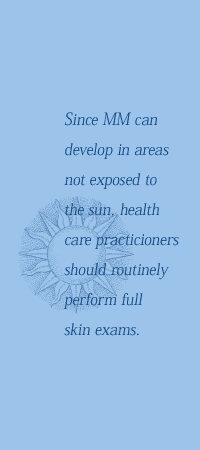

VII. Policy initiatives that would affect skin cancer awareness and prevention [ 29 , 30 ]
| A.
Workplace exposure
Many occupations involve outdoor exposure, yet UV radiation is not regarded as a work-place health hazard by the national or state Occupational Health and Safety Agency, probably because BCC and SCC develop over time. Prototype workplace protection policies should include: |
|
| • | Educating management and workers on skin cancer awareness, including risk factors, prevention, and self skin-exam. |
| • | Soliciting input from workers and management regarding the wearing of appropriate hats, clothing, and glasses (to prevent eye damage from UV radiation). |
| • | Providing sunscreen as part of workplace safety measures. |
| • | Making portable shade structures available whenever possible; this is especially feasible during lunch breaks at outdoor work sites. |
| • | Arranging work schedules so that, when that option exists, outdoor tasks are to be performed before 10 A.M. and after 4:00 P.M. |
| B. Schools and recreational exposure | ||||
| 1.
Schools and community summer programs
Minimizing sun damage at day care facilities and schools relies on administrators, teachers, attendants, and parents understanding the skin cancer risk for children and adolescents. Suggested policy includes: |
||||
| • | Having teachers and caregivers model sun-safe behavior, including use of sunscreen and protective clothing. | |||
| • | Obtaining parental permission to apply sunscreen to young children prior to outdoor play or recess. | |||
| • | Incorporating UV radiation and skin cancer awareness into the school curriculum. (e.g. Project S.A.F.E.T.Y., or the EPA SunWise Program). | |||
| • | Involving students in UV radiation measurements. | |||
| • | Scheduling recess and outdoor activity times before 10 A.M. and after 4:00 P.M, if at all possible. | |||
| • | Developing permanent shade structures at play and sport areas. | |||
| • | Including shade protection in the requirements of a safe play ground. | |||
| • | Planting trees for shade in public areas in or around play ground or recreational areas. | |||
| 2.
Parks, beaches , sports facilities Information and awareness measures include: |
||||
| • | Placement of educational posters advising against tanning or burning, and advocating sun-safe behavior. | |||
| • | Daily UV radiation readings and related skin cancer prevention advice. | |||
| • | Sunscreen availability through shops or vending machines. | |||
| 3.
Tanning
salons Section 145.001 of the State of Texas Health and Safety Code requires tanning facilities to "give each customer a written statement warning thatŠrepeated exposure may result in premature aging of the skin and skin cancer." This warning should also be posted in a sign readily visible to "persons entering the establishment." Time under the ultraviolet light is not to exceed certain guidelines, users younger than 18 need written consent from a parent to use the facilities, and users under 14 are to be accompanied by a parent. These regulations are measures against misuse; violations are the responsibility of the municipalities in which the tanning salons are located. Enforcement is currently inadequate. |
||||
| C. Need for skin cancer awareness in educational curricula | ||||
| 1.
Schools, K-12
Excessive sun exposure during the first 10 to 20 years of life greatly increases the risk of skin cancer, and blistering sunburns in youth result in an increased risk for developing MM. Under normal circumstances, children receive three times the annual sun exposure of adults. Children born today have a four to five times greater risk for developing MM in their lifetimes than their parents generation had. Sun exposure is the only avoidable risk factor for melanoma; since most sun damage occurs early in life, the sooner sun safe behaviors start, the better. (Project S.A.F.E.T.Y, 1995) The State Board of Education sets curriculum for schools in Texas; currently only high schools are required to teach health, and that requirement covers only one semester. |
||||
| 2.
Teacher
's curriculum The education of teachers in skin cancer awareness creates a favorable atmosphere for understanding the problem in Texas. It prepares the groundwork for subsequently teaching skin cancer prevention in the classroom. The Texas School Board requires only high schools to conduct a course in health. Skin cancer may or may not be part of that curriculum, but prepared teachers are more likely to utilize skin cancer education modules available from various sources, for students K-12. |
||||
| 3.
Health-care
practitioners' curricula The curricula for physicians, dentists, nurse practitioners, physician assistants, nurses (R.N. and L.V.N.), and physical therapists, provide opportunities for raising the current level of professional education in skin cancer prevention and detection. Educated providers would increase access to care for the general population. 4 . Pre-school and day care worker training Comprehensive training of day-care staff and education of parents form the basis for an effective skin cancer prevention program in young children. Workers usually need to obtain written parental permission to apply sunscreen to the children under their care. |
||||
| 4.
Pre-school and day care worker training Comprehensive training of day-care staff and education of parents form the basis for an effective skin cancer prevention program in young children. Workers usually need to obtain written parental permission to apply sunscreen to the children under their care. |
||||
